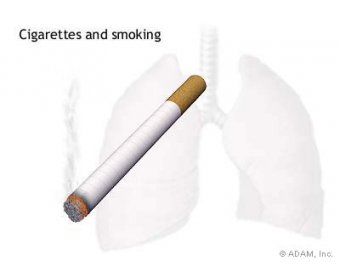
Background information on smoking
Nearly 21% of adults in the United States smoke, according to a 2009 report by the U.S. Centers for Disease Control and Prevention (CDC). Smoking had steadily declined among adults in recent years; though the trend has stalled between 2004 and 2006, according to the latest CDC report there was a 1% drop in smoking prevalence among U.S. adults in 2007.

The addictive effects of tobacco have been well documented. Tobacco is considered to be a mood and behavior altering substance that is psychoactive and abusable. Tobacco is believed to be as potentially addictive as alcohol, cocaine, and morphine. Tobacco and its various components increase the risk of cancer (especially in the lung, mouth, larynx, esophagus, bladder, kidney, colon, pancreas, and cervix), heart attacks, strokes, and chronic lung disease.
Smoking in Childhood and Adolescence
The younger children start smoking, the more likely they will smoke as adults. Smoking is often rapidly addictive. According to the American Cancer Society, the earlier you start smoking, the more likely you are to develop long-term nicotine addiction.
In the past, advertising played a major role in encouraging some teens to smoke. New regulations have made it much more difficult for advertisers to promote smoking to young people. However, scenes that show people smoking, often in a positive way, are still common in movies and television shows. This may be a major influence on the attitude toward smoking in children and adolescents.
To prevent children from smoking, parents should not smoke, and they should tell their child that they disapprove of smoking. Studies have shown that schoolchildren who believed that both their parents strongly disapproved of smoking were less than half as likely to smoke as those kids whose parents did not show as much disapproval towards smoking.
Children whose parents closely monitor their television and music-listening habits are less likely to drink, use drugs, and smoke cigarettes.
Neglected children, or children with absentee parents, are four times as likely to abuse drugs, drink, and smoke as children living with parents who were regularly present and who offered a structured lifestyle.
Doctors can have a major effect on young people. However, in one survey, less than half of teenagers had ever been asked by their doctors if they smoked, or were counseled not to smoke, even though most teen smokers said they would admit to it if asked.
Of special concern iare recent studies that indicate smoking in adolescents is directly linked to suicidality in this age group. Teens who smoke are more likely to attempt suicide than their non-smoking peers.
Gender, Age, and Ethnicity
| Age | Total | ||
| 18 - 44 years | 23.1% | ||
| 45 - 64 years | 22.6% | ||
| 65 - 74 years | 12.4% | ||
| 75 years and older | 5.7% | ||
| Source: CDC/National Health Interview Survey 2008 | |||
While the number of adults over 65 who smoke is lower than those in other age groups, older adults usually have smoked for a long time (about 40 years) and tend to be heavier smokers, according to the American Lung Association. Because of this, older smokers are more likely to have smoking-related illnesses.
Caucasian students (under age 18) are more likely to smoke than Hispanics and African-Americans. In 2008, the rate of smoking was highest among American Indians and Alaskan natives. Hispanics and Asians had the lowest rates.
Geography
In general, the rate of smoking is highest in the Midwest and South and lowest in the Northeast and West. Utah has the lowest rate of smoking in the United States.
Educational Level
A major U.S. government study reported that people who have not graduated from high school or received their General Education Development (GED) certificate tend to have higher smoking rates than those who attended college.
Higher rates of cigarette smoking have been reported among adults who have earned a GED and those with a 9 - 11 grade education. The lowest rates are seen among those with advanced college degrees.
Psychological Factors
People with low self-esteem and adolescents with behavioral problems have a higher risk for smoking. Men and women with mental disorders are 50% more likely to smoke than those without such illness. For example, depression and schizophrenia are known risk factors for smoking. Both may actually have biological effects that are responsible for this higher risk.
Smoking Among Persons with Disabilities
Smoking is much more common among persons with disabilities than those without emotional, mental, or physical limitations. A 2007 Centers for Disease Control study found that the rate of smoking is nearly 50% higher among persons with disabilities. The CDC survey included those with mental illness and drug and alcohol addictions in the disabled group.
Genetic Factors
Evidence now strongly supports the idea that genes play a role in a person's dependence on nicotine. Researchers are now targeting specific genes that may be responsible for nicotine dependence. So far, research has shown that there is a common genetic vulnerability to both nicotine and alcohol dependence.
VIDEO REVIEWS


Share this Post
Related posts
Surgeon General report on smoking
Order Documents Order 2014 Surgeon General s Report documents from our Publications Catalog. In the Publications Catalog…
Read MoreResearch paper on smoking cigarettes
Since 1994, multiple legal and scientific developments have altered the tobacco control environment and thus have affected…
Read More










